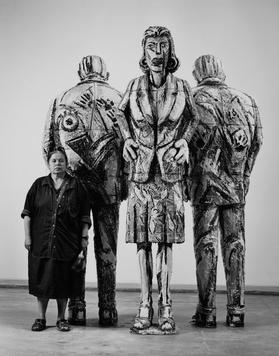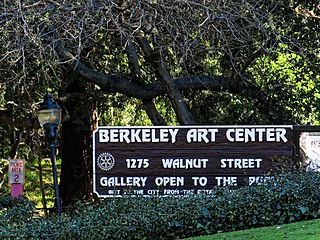Mary Curtis Ratcliff | |
|---|---|
 | |
| Born | 1942 (age 81–82) Chicago, Illinois |
| Alma mater | Rhode Island School of Design |
| Occupation | Artist |
| Spouses |
|
| Website | www |
Mary Curtis Ratcliff (born 1942) is an American visual artist.
Mary Curtis Ratcliff | |
|---|---|
 | |
| Born | 1942 (age 81–82) Chicago, Illinois |
| Alma mater | Rhode Island School of Design |
| Occupation | Artist |
| Spouses |
|
| Website | www |
Mary Curtis Ratcliff (born 1942) is an American visual artist.
Mary Curtis Ratcliff was born in Chicago and grew up in Birmingham, Michigan. [1] She attended the Rhode Island School of Design and graduated with a Bachelor of Fine Arts degree in 1967. [2]
She moved to New York, living with artist David Cort on Rivington Street. After Cort met Parry Teasdale while shooting video at Woodstock in 1969, the three founded a collective which came to be known as the Videofreex. [3] [4] [5] [6] [7] The group's early endeavors included covering countercultural subjects in Manhattan and California, and a trip to Chicago to interview Yippie leader Abbie Hoffman and Black Panther leader Fred Hampton, providing an alternate perspective to that of mainstream television. [8] This footage was hastily compiled into a pilot for a prospective CBS television magazine series titled Subject to Change. However, after an unconventional screening at the Videofreex loft in lower Manhattan, network executives declined to move forward with the project. [8] [9]
Another of the group's videos was Curtis' Abortion, in which Ratcliff and two other women members of the Freex candidly discussed an abortion Ratcliff underwent in 1970, shortly after the procedure had been legalized in New York, contrasting that experience with previous illegal ones they had undergone. [3] [6]
The Freex moved to Upstate New York in 1971 to avail themselves of New York State Council on the Arts grants and eventually developed a pirate television station named Lanesville TV that operated out of their commune on Maple Tree Farm. [3] [10] Ratcliff, increasingly disillusioned with collective life and decision-making, married Cy Griffin and left the collective at this point.
All the guys showed up and me. We sat in a circle and we all talked. And I said something. And I was totally ignored. And I said it again ... the guys probably don't remember it, but I certainly do. And I was totally ignored. And I looked around and said I am really over this. I can't be a part of a group where no one can give me any type of dialogue, any respect. That is when I started walking out the door. [7]
She collaborated with Griffin on a multi-projector synchronized slideshow with sound called Daze of Syracuse: Past, Present and Future at the Everson Museum, [11] visited the Rosebud and Pine Ridge Reservations with him in South Dakota, documenting and engaging in the Sundance Ceremonies with the Lakota Sioux in 1971 and 1972. After that, she moved to California, divorced Griffin, and resumed her career as an individual artist.

Ratcliff's early artistic work focused on sculpture. In the 1970s she produced kinetic figures made from hoops and ribbons. [12] Many of her works from this time were used in processions and dances by the emergent Goddess movement, [1] [13] and her aerial sculpture Amelia, an homage to Amelia Earhart, hung over the stage at the "Great Goddess Re-emerging" Conference at the University of California, Santa Cruz. In the mid-1980s she worked at Industrial Light & Magic, feathering costume heads for the film Howard the Duck . Later freestanding sculptures of the early 1990s, such as Josephine, an homage to Josephine Baker, took on abstracted standing goddess forms. She later moved on to smaller works, such as a series based on the form of decorated cakes, titled Mixed Messages. [14] [15] [16] [17]

At the suggestion of artist Helène Aylon, she participated in residency programs at the Virginia Center for the Creative Arts in 1997 and 1999. [15] At these she began to transition from working mainly in sculpture to two-dimensional mixed media. [1] Over the next 20 years, her artistic technique grew to include layered elements of drawing, collage, image transfer, and photography. [2] [18] Beginning in 2016, Ratcliff began combining her focus on nature-based imagery using mixed media techniques with a return to kinetic sculpture, notably in the exhibitions Full Circle, What Goes Around Comes Around, and Circumference. [19]


Her work is included in the collections of the Oakland Museum of California and the Fine Arts Museums of San Francisco. [5] [19]
Ratcliff is a member of the National Organization for Arts in Health In 2018, she launched the website Healing Circle Artworks to explore the placement of art in hospitals and public spaces.
In 2019 she was awarded a Civic Arts Grant by the city of Berkeley. [20]
Mary Curtis Ratcliff lives in Berkeley, California with her husband, SFMOMA curator Peter Samis. [21]

The California College of the Arts (CCA) is a private art school in San Francisco, California. It was founded in Berkeley, California in 1907 and moved to a historic estate in Oakland, California in 1922. In 1996, it opened a second campus in San Francisco; in 2022, the Oakland campus was closed and merged into the San Francisco campus. CCA enrolls approximately 1,239 undergraduates and 380 graduate students.
The Bay Area Figurative Movement was a mid-20th Century art movement made up of a group of artists in the San Francisco Bay Area who abandoned working in the prevailing style of Abstract Expressionism in favor of a return to figuration in painting during the 1950s and onward into the 1960s.

Manuel John Neri Jr. was an American sculptor who is recognized for his life-size figurative sculptures in plaster, bronze, and marble. In Neri's work with the figure, he conveys an emotional inner state that is revealed through body language and gesture. Since 1965 his studio was in Benicia, California; in 1981 he purchased a studio in Carrara, Italy, for working in marble. Over four decades, beginning in the early 1970s, Neri worked primarily with the same model, Mary Julia Klimenko, creating drawings and sculptures that merge contemporary concerns with Modernist sculptural forms.
Salma Arastu is an internationally exhibited woman artist known for her unique global perspective, reflecting her diverse cultural background and experiences. Born in Rajasthan, India, Aratsu pursued her formal education in Fine Arts at Maharaja Sayajirao University in Baroda, India. She was raised in the Sindhi and Hindu traditions and later embraced Islam and moved to the USA in 1986, currently residing in California. As a woman, artist, and mother, Arastu's creative endeavors aim to foster harmony and express the universality of humanity through various art forms, including paintings, sculpture, and poetry. She has also worked extensively with calligraphy and produces greeting cards for the American Muslim community.
Peter Forakis was an American artist and professor. He was known as an abstract geometric sculptor.
JB Blunk (1926–2002) was a sculptor who worked primarily in wood and clay. In addition to the pieces he produced in wood and ceramics, Blunk worked in other media, including jewelry, furniture, painting, bronze, and stone.
Guy Overfelt is an American multi-disciplinary post-conceptual artist. He works with various media including sculpture, performance, photography, video and drawing. He is based in San Francisco and Bolinas, California.

Viola Frey was an American artist working in sculpture, painting and drawing, and professor emerita at California College of the Arts. She lived and worked in the San Francisco Bay Area and was renowned for her larger-than-life, colorfully glazed clay sculptures of men and women, which expanded the traditional boundaries of ceramic sculpture.
Mary Fuller McChesney was an American sculptor and art historian. She was a 1975 National Endowment for the Arts fellow.

Edwin Deakin was a British-American artist best known for his romantic landscapes as well as his architectural studies, especially the Spanish colonial missions of California. His still lifes are considered to be some of the finest of the genre. Deakin is one of the artists who popularized scenes of San Francisco's Chinatown. His sensitive and highly publicized depictions of the deteriorating missions drew public attention to the necessity of restoring these historically important monuments.
Lia Cook is an American fiber artist noted for her work combining weaving with photography, painting, and digital technology. She lives and works in Berkeley, California, and is known for her weavings which expanded the traditional boundaries of textile arts. She has been a professor at California College of the Arts since 1976.

Benny Alba is an artist who lives in Oakland, California.
Mike Mandel is an American conceptual artist and photographer. According to his artist profile, his work "questions the meaning of photographic imagery within popular culture and draws from snapshots, advertising, news photographs, and public and corporate archives."
Nance O'Banion (1949-2018) was an Oakland based American artist who "pioneered creative explorations of handmade paper". She is known for her sculptural paper works and book works which focus on themes of change and transformation. A retrospective sample of the arc of her work may be viewed at: https://nance-obanion.com
Adelie Landis Bischoff, was an American artist and painter, active in the San Francisco Bay Area. She was the wife of artist Elmer Bischoff.
Jacques Schnier (1898–1988) was a Romanian-born American artist, sculptor, author, educator, and engineer. He was a sculpture professor at the University of California, Berkeley from 1936 to 1966.
Libby Black is an American contemporary artist working primarily in drawing, painting, and sculpture. Black lives and works in Berkeley California.
Jan Rindfleisch is an American artist, educator, author, curator, and community builder. Rindfleisch is known for the programming she initiated and oversaw at the Euphrat Museum of Art; for her book on the history of art communities in the South Bay Area, Roots and Offshoots: Silicon Valley's Art Community, and for her role in documenting the careers and legacies of Agnes Pelton and Ruth Tunstall Grant.
Nancy Genn is an American artist living and working in Berkeley, California known for works in a variety of media, including paintings, bronze sculpture, printmaking, and handmade paper rooted in the Japanese washi paper making tradition. Her work explores geometric abstraction, non-objective form, and calligraphic mark making, and features light, landscape, water, and architecture motifs. She is influenced by her extensive travels, and Asian craft, aesthetics and spiritual traditions.

Berkeley Art Center (BAC) is a nonprofit arts organization, community art space, and gallery founded in 1967 and located at 1275 Walnut Street in Live Oak Park, Berkeley, California.